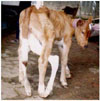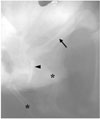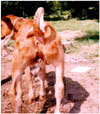Congenital defects, defined as abnormalities of structure or function that are present at birth, occur relatively frequently in cattle [8]. These defects can result from either defective genetics or from a genetic insult/agent that's associated with the fetal environment or from their interaction; these defects are classified as lethal, sub-lethal and nonlethal [7]. The susceptibility to an injurious environmental or to genetic agents varies with the stage of development and between species, and the susceptibility decreases with advancement of fetal age. The frequency of individual defects varies with the species, the breed, the geographic location, the season and other environmental factors. The incidence is estimated to range from 2% to 3.5% of all birth in calves, lambs and foals [1].
In a cattle survey, the percentages for the occurrence of congenital defects were reported as the musculoskeletal system: 24%, the respiratory and alimentary tracts: 13%, the central nervous system: 22%, the abdominal wall: 9%, the urogenital system: 4%, the cardiovascular system: 3%, the skin: 2%, and others: 4% [7].
Congenital malformation sometimes leads to perinatal mortality, and it may also decrease maternal productivity and reduce the value of the defective neonates. Severe defects results in abortion of the calf or a return to service of the calf and cow [9]. Scientific reports on congenital anomalies are not frequent in Bangladesh, but some individual reports indicate the common congenital abnormalities in new born calves involving the digestive system are the most frequent (37.04%), and this is followed by the musculoskeletal system (24.07%), the integumentary system (20.37%), and the hematopoietic system (1.85%) [10]. Skeletal defects are common, and the skeletal system may be affected in its entirety or with single, isolated defects [5,6].
Congenital anomalies with accessory limbs occur very rarely in calves and there are few, if any, reports on such incidences in Bangladesh. A case of supernumerary limb in a calf was reported on long ago [4], yet this is the first case of pygomelia to be reported in this country. The present study was reported as a most interesting clinical case that required surgical intervention.
A (Sindhi × local indigenous) crossbred calf that was 12 days old was admitted to the Teaching Veterinary Hospital, Chittagong Government Veterinary College, Bangladesh, and the calf was referred by a Upazila Livestock Officer (Chittagong Hathazari, Bangladesh), because of the calf's two accessory limbs that were attached to the pelvic region (Fig. 1).
On physical examination the calf was found quite normal except for the additional limbs. On radiographic examination, it was confirmed that both accessory limbs were attached to the ischium in shallow acetabulums slightly caudomedial to the other true functional limbs, and these accessory limbs formed true joints. This was also confirmed later after separation of the accessory limbs (Fig. 2).
The pelvic area was prepared for aseptic surgery. The animal was intravenously premedicated with diazepam (Square, Bangladesh.) at 0.08 mg/kg body weight. After 10 minutes the animal was intravenously anaesthetized with a combination of xylazine (Indian Immunologicals, India) at 0.2 mg/kg body weight and ketamine (Rotexmedier GmBH, Germany) at 3 mg/kg body weight. The animal was also stabilized with 5% dextrose saline (Beximco Infusion, Bangladesh) for the entire operation period.
First, a half-round incision was made 3 cm from the base of one limb. The fascia was then carefully cut with avoiding cutting any larger blood vessels. The larger blood vessels, namely the femoral, medial circumflex femoral and lateral circumflex femoral arteries and veins that supplied the accessory limbs [3], were doubly ligated by number 0/4 catgut. Bleeding from the small blood vessels was controlled via electric cautery. The different muscle layers, e.g., the psoas major, iliacus, gluteus medius, gluteus accessorius, gluteus profundus, gluteobiceps, semitendinosus, semimembranosus, rectus femoris, sartoris, gracilis, pectineus, adductor, quadratus femoris, obturatorius externus and etc [2], were incised carefully to reach up to the articulation. The transverse acetabular ligament and the capsule of the joint [14] was also incised and the head of the femur was disarticulated from the acetabulum. The other limb was also detached in the same way. Finally, the two accessory limbs were detached (Fig. 3) and the wound was closed accordingly (Fig. 4).
During the post operative period, the animal was injected with the antibiotic ampicillin at 7 mg/kg body weight (Square, Bangladesh) bid for 8 days. It was also injected with the antihistaminic pheniramine maleate at 0.5 mg/kg body weight (ACI Animal Health, Bangladesh) intramuscularly sid for 5 days. The animal was also supplemented intramuscularly with a vitamin B complex preparation (Reneta, Bangladesh) at 2 ml on every alternative day.
When additional limbs attached to the pelvic region, it is called pygomelia [12]. Polymelia is the duplication of a whole limb, and it is frequently occurring congenital malformation; operative removal of the surplus limb can be carried out successfully [11]. The animal can survive successfully if the operation is done under proper aseptic conditions and appropriate post operative care is taken [13].
Two months after the operation, the animal was further examined and it was found to be quite normal (Fig. 5).
A lot of different types of congenital defects occur in calves, but pygomelia is comparatively rare. This report provides successful evidence that this defect can be corrected successfully if proper measures and timely surgical intervention are undertaken.




 PDF
PDF ePub
ePub Citation
Citation Print
Print







 XML Download
XML Download